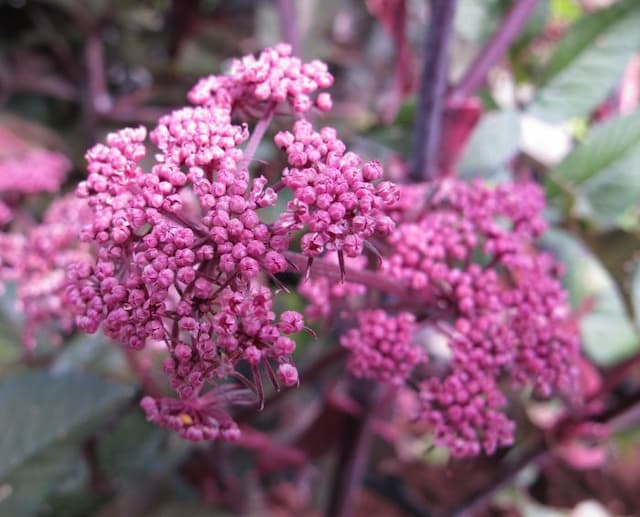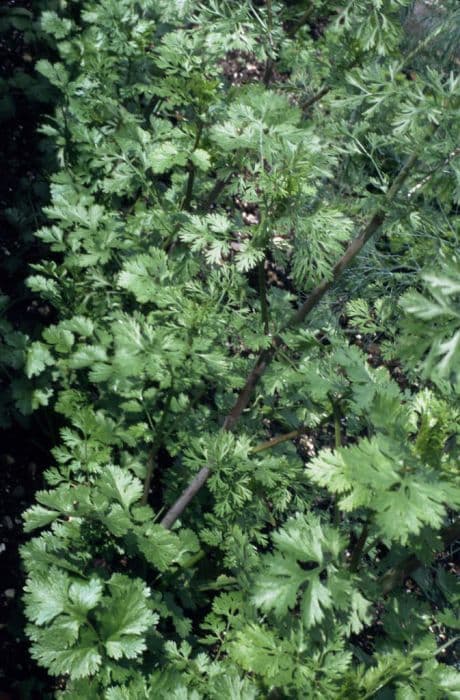Hogweed Heracleum sphondylium

ABOUT
The plant commonly known as cow parsnip is a herbaceous species that typically has a stout, hollow stem with bristly hairs. The leaves of this plant are large, divided, and can be described as compound. Each leaf is intricately divided into smaller leaflets, which are toothed and lobed, giving them a somewhat jagged appearance. The overall shape of the leaves can be somewhat triangular or heart-shaped. Cow parsnip's flowers are a key characteristic. They are grouped in large, flat-topped clusters known as umbels, which resemble an upside-down umbrella. These umbels are composed of many small, white flowers, each with five petals, tiny sepals, and pronounced stamen. These flowers are generally arranged in a distinctive pattern that is radiating from a single point and can cover quite a broad area at the top of the stems. The stems culminate in these impressive umbels, and the flowering part can be quite noticeable due to its substantial presence. The intricate structure of the flower clusters lends a delicate, lacy appearance to the plant, despite its robust stems and large leaves. The seeds of cow parsnip are flat and winged, allowing them to be dispersed effectively by the wind. After flowering, the plant produces these seeds that ensure the spread and continuance of the species. Below ground, the plant has a strong root system that anchors it into the soil. This system is efficient in absorbing water and nutrients, which supports the substantial above-ground growth of cow parsnip. The overall appearance of cow parsnip is a mixture of strength and delicacy, with substantial foliage and a commanding presence in the setting it grows, contrasted by the fine details of its large floral displays.
About this plant
 Names
NamesFamily
Apiaceae
Synonyms
Common Hogweed, Cow Parsnip, Hogweed, Eltrot, Keck
Common names
Heracleum angustisectum, Heracleum lanatum, Heracleum pubescens, Heracleum sibiricum, Heracleum villosum, Pastinaca sphondylium.
 Toxicity
ToxicityTo humans
The plant known as hogweed contains chemical compounds that can be toxic to humans. While not typically considered deadly poisonous if ingested, the greater risk lies in its sap which contains furocoumarins. These compounds can cause a skin reaction known as phytophotodermatitis when contacted skin is exposed to sunlight, resulting in blistering, lesions, and long-lasting scars. The eyes are particularly sensitive and if sap gets into them, it can cause temporary or permanent blindness. Ingesting parts of hogweed may lead to gastrointestinal distress, though this is rarer and often less serious than the external skin reactions.
To pets
Hogweed can be toxic to pets as well. If an animal ingests part of the plant, they may experience drooling, mouth sores, diarrhea, or vomiting. Like humans, the primary concern is the sap, which can cause similar phototoxic reactions to their skin or fur. If your pet comes into contact with the sap and then goes into sunlight, they can develop severe skin irritation and burns. It's important to prevent pets from chewing on or otherwise coming into contact with this plant due to its potential to cause harm both internally and externally.
 Characteristics
CharacteristicsLife cycle
Biennials
Foliage type
Deciduous
Color of leaves
Green
Flower color
White
Height
5-6 feet (1.5-1.8 meters)
Spread
2-3 feet (0.6-0.9 meters)
Plant type
Herb
Hardiness zones
5
Native area
Europe
Benefits
 General Benefits
General Benefits- Wildlife Habitat: Heracleum sphondylium, commonly known as hogweed, provides habitats for various insects and birds, offering shelter and breeding grounds.
- Pollinator Attraction: The flowers attract a range of pollinators including bees, butterflies, and beetles, supporting biodiversity.
- Soil Improvement: Hogweed's deep roots can help to break up compacted soil, improving soil structure and fertility over time.
- Erosion Control: The extensive root system of hogweed helps to stabilize soils, particularly on slopes and riverbanks, reducing erosion.
- Edibility: Some parts of the plant can be used in cooking, although caution is advised due to similarity to toxic relatives.
- Cultural Significance: Hogweed has been a part of traditional practices and folklore in various cultures, enriching the local heritage.
- Biological Control: Hogweed can be used as a companion plant in agriculture to deter certain pests, reducing the need for chemical pesticides.
- Aesthetic Value: With its large, umbrella-shaped flower clusters, hogweed can add visual interest to natural landscapes and gardens.
 Medical Properties
Medical Properties- Heracleum sphondylium, commonly known as cow parsnip, has been used in traditional medicine for its perceived anti-inflammatory properties.
- The plant has been traditionally used as a diuretic, potentially increasing the passage of urine.
- Cow parsnip has also been used for digestive disorders, being believed to help relieve flatulence and intestinal cramping.
- It has been applied historically as a folk remedy for skin conditions and wounds, suggesting antiseptic qualities.
- In some traditional practices, parts of cow parsnip are used to relieve respiratory conditions, such as coughs and colds.
- This plant has been reportedly used in the treatment of fevers, suggesting it may have febrifuge properties.
 Air-purifying Qualities
Air-purifying QualitiesThis plant is not specifically known for air purifying qualities.
 Other Uses
Other Uses- As a vegetable: Young shoots and leaves of Heracleum sphondylium, commonly known as cow parsnip, can be cooked and eaten like a vegetable.
- Tanning leather: The tannins present in cow parsnip can be used for tanning leather.
- Textile dye: The plant's sap yields a yellow dye used in textile dyeing processes.
- Fishing aid: In some traditions, the juice of cow parsnip was used to poison or stupefy fish, making them easier to catch.
- Insect repellent: Cow parsnip has been used traditionally to repel insects, though care must be taken due to the skin irritant properties of its sap.
- Photographic development: The sap contains furocoumarins, which can be used in alternative photographic processes, such as in creating "photograms" by placing objects on photosensitive paper.
- Garden ornamental: Despite its potential invasiveness, cow parsnip is sometimes planted in gardens for its tall stature and large, attractive flower umbels.
- Soil improvement: Cow parsnip's deep roots can help to break up dense soil and improve soil structure upon decomposition.
- Fodder for animals: In some areas, cow parsnip is used as fodder for livestock, particularly for pigs and goats, which are less sensitive to its irritant properties.
- Ritual uses: In various cultures, parts of the cow parsnip have been used in ritual practices or as part of traditional herbal wreaths.
Interesting Facts
 Feng Shui
Feng ShuiThe Hogweed is not used in Feng Shui practice.
 Zodiac Sign Compitability
Zodiac Sign CompitabilityThe Hogweed is not used in astrology practice.
 Plant Symbolism
Plant Symbolism- Invasiveness: Heracleum sphondylium, commonly known as hogweed, can symbolize the idea of being invasive or overwhelming, as the plant is known to spread aggressively and can dominate the areas where it grows.
- Resilience: Hogweed is tough and can grow in challenging conditions, making it a symbol of resilience and the ability to thrive despite adversity.
 Water
WaterCommon hogweed requires consistent moisture, especially during its active growth in the spring and summer. Water the plant thoroughly, providing about 1 to 2 gallons every week, depending on rainfall and soil conditions. The soil should remain moist but not waterlogged. During the winter months, reduce watering as the plant goes dormant and requires less moisture. Ensure that you water at the base of the plant to avoid wetting the foliage, which could lead to fungal diseases.
 Light
LightCommon hogweed prefers full sun to partial shade. It thrives best in an area where it can receive at least six hours of sunlight a day. However, it can tolerate some shade and would still grow well in dappled sunlight found under open canopies or at the edges of woodland.
 Temperature
TemperatureThe common hogweed can withstand a wide range of temperatures but grows best when the temperature is between 50°F and 77°F. It can survive temperatures down to around 14°F but may die back to the ground in winter, returning in the spring. The plant is resilient to high temperatures as long as its soil moisture needs are met.
 Pruning
PruningPruning common hogweed is vital to control its size and remove any spent flower heads to prevent self-seeding, especially as it can become invasive. Prune in late winter or early spring before new growth begins. Pruning can be done annually, removing dead stems and shaping the plant to encourage healthy growth.
 Cleaning
CleaningAs needed
 Soil
SoilHogweed prefers a soil mix that is rich, moist, well-drained, and high in organic matter with a pH range between 6.0 and 7.0. To create the best mix, combine loamy soil with compost and peat moss to ensure fertility and adequate moisture retention.
 Repotting
RepottingThe common hogweed does not typically require repotting as it is usually managed as a wild perennial or biennial. If grown in a container, repot it every 2-3 years or when the plant outgrows its pot.
 Humidity & Misting
Humidity & MistingHogweed thrives in average outdoor humidity levels. It is adaptable to different humidity conditions and does not require any special humidity adjustments when grown in its natural habitat.
 Suitable locations
Suitable locationsIndoor
Ensure moist soil, indirect sunlight, and space for growth.
Outdoor
Plant in semi-shade, moist soil, and space to accommodate size.
Hardiness zone
4-9 USDA
 Life cycle
Life cycleHeracleum sphondylium, commonly known as cow parsnip, begins its life cycle as a seed, typically germinating in early spring upon exposure to moisture and the warming temperatures. The seeds grow into rosettes of large, lobed leaves close to the ground in their first year, establishing a strong root system. In the second year, the plant sends up a tall flower stalk that can reach up to two meters, topped with umbels of white flowers that attract various pollinators and bloom through summer. After pollination, the flowers develop into flat, oval seeds that disperse into the surrounding environment. The plant then completes its biennial cycle by dying back after seed dispersal, relying on the new generation of seeds to propagate the species. Meanwhile, the plant can also expand vegetatively through its root system, creating a clump of new plants over time.
 Propogation
PropogationPropogation time
Spring-Early Summer
Propogation: The common hogweed, Heracleum sphondylium, is generally propagated through seed. The ideal time for sowing the seeds of common hogweed is in the fall or early spring. Seeds should be scattered directly onto a well-prepared seedbed that has been cleared of weeds and raked to a fine tilth. As they require light to germinate, the seeds should be sown shallowly or simply pressed into the surface of the soil. To ensure a good rate of germination, maintain the soil moisture until the seedlings are well established. Seedlings can then be thinned out to the appropriate spacing to allow for mature growth. In its natural setting, common hogweed will also self-seed readily, which can be a method of natural propagation.








